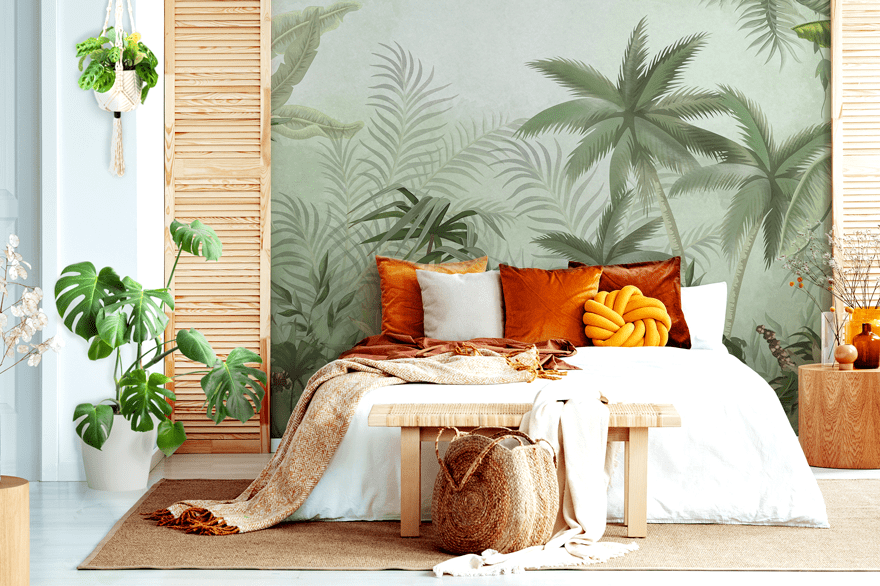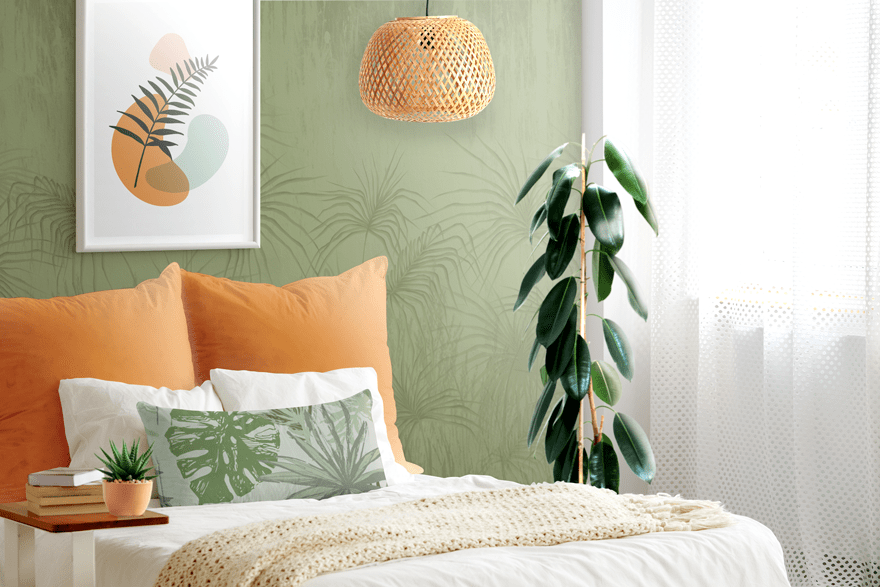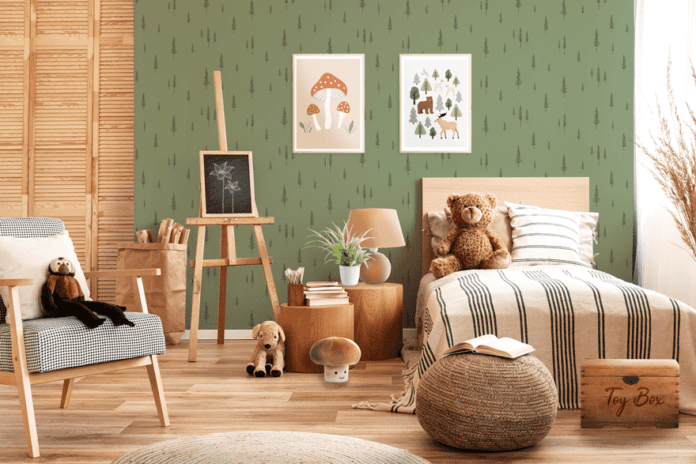Reconnecting you with nature and encouraging you to embrace the outdoors (no matter the season), friluftsliv is not just a trend but a way of life. It is described as spending time in nature for your spiritual and physical health and appreciating the beauty of the natural world.
However, creating a calming environment is essential for good sleep hygiene (a strong routine that promotes the importance of sleep), and your bedroom decor can play a big part in that.
So, the experts at Happy Beds have created various unique visuals to show you what a ‘friluftsliv’ bedroom looks like before sharing their 10 must-haves.

- Choose a pared-back, earthy palette to promote higher-quality sleep.
Warm, neutral colours are the perfect colour for a friluftsliv bedroom. green, warm white, light brown, blue and muted orange. These colours capture the outdoor world, bounce light around the room and can even help to make smaller rooms appear bigger.
Additionally, the colour green can help reduce blood pressure, regulate the inner balance of your body and even help to overcome insomnia due to its calming qualities.
- Pick white, organic bedding that’s breathable and creates calmness and tranquillity.
Quite literally woven into the fabric of friluftsliv, you should opt for bedding made of 100% natural materials, such as cotton or silk. These materials are more breathable and can prevent a person from getting night sweats or hot flushes which can cause disruption during a slumber.
You should also aim to pick white bedding. Not only does white work perfectly with the friluftsliv trend, but it is the best bed linen colour to sleep in. The colour is associated with calm and tranquillity, meaning you are more likely to fall asleep in them when it comes to bedtime.
- Work in real wood furniture to help regulate your nervous system.
Wood is the most common and easily accessible material for your bedroom and boasts a very close-to-nature vibe. Plus, wood and floral smells can regulate your nervous system and get you to sleep quicker
Smells such as cedarwood – with its organic, woody tones – and aromas from flowers and plants can help regulate your nervous system and get you to sleep. A study found that groups inhaling yuzu fragrance before bed went to sleep easier than those that didn’t, and even felt better the next day.
- Add a coriander plant to promote more restorative sleep.
Surprisingly, you should consider adding a coriander plant to your bedroom. Interestingly, studies have found that inhaling the smell of coriander can reduce your REM latency, or the time it takes you to fall into your first REM sleep stage which, typically, lasts around 90 to 120 minutes. REM sleep is particularly important for learning and memory. Without it, you can become sad, tired, unproductive and struggle to complete everyday tasks. However, if you’re not keen on coriander or its smell, other sleep-inducing plants include snake plants, spider plants and gardenia.

- Opt for plant-patterned wallpaper to elicit more positive emotions.
Searches for ‘succulent wallpaper’ have increased by 27% in the last 12 months. This type of wallpaper typically features a multitude of natural greens, blues and browns, among many other colours and replicates the beauty of the outside world. And, there are even health benefits to this type of wallpaper.
Studies have found that exposure to the imagery of natural environments can elicit strong, positive emotions and lead to better relaxation than images of urban environments. This is another reason to consider nature when designing your room.
- Or add artwork which is calming.
Alternatively, if you don’t want to add wallpaper, you can add calming artwork which mimics nature. If you are unsure of what artwork to add, think about matching it to the style of your home. So, if you live in a home by the river or your house is very bright and airy, look at incorporating beach artwork into your bedroom. If you live in a cottage-style home, go for art featuring forests and mountains. For those who live in urban areas, any natural scenery will help such as walking trails or woodland areas. The importance is having a form of escapism in your bedroom.
- Add a handwoven rug to prevent noise disruption if you sleep with a partner.
If you have wooden floors and you would like to warm them up a little more, a handwoven, shaggy rug is the way to go. Not only do these help the space feel cosy and comfortable, but they also drown out any disruptive noises. For example, if you add a rug to your bedroom, you’re less likely to be woken up by a partner who comes to bed at a later time.
- Makes sure your bulbs are warm-toned to produce more melatonin at night.
It’s important to choose lighting that reflects natural light during the day but encourages you to wind down and sleep at night – otherwise your circadian rhythm (internal body clock) will be confused. Therefore, the best option is to choose a bulb which is more warm-toned, or ones that can change colour and that become warmer toned as the night progresses. This, therefore, helps your body produce more melatonin, which makes you feel sleepier.
- Pick on-trend mushroom motifs.
Did you know that searches for ‘mushroom decorations for room’ have increased by 300% in the past three months? So, what better way than celebrating the growing trend by making it part of a the ‘friluftsliv’ trend. You can incorporate mushrooms in a number of ways. From the colours of mushrooms and textures and styles of mushrooms – light brown to off-white – to the shapes of mushrooms with your ornaments or even bedside lamps. There are also mushroom art prints you can hang up, and you can even make your own spore prints by using real mushrooms to hang on your wall for a true feel of the outdoors.
- Make your bedroom feel as open-air living as possible – or opt for white, sheer curtains.
Ultimately, friluftsliv is about outdoor living. By bringing the outdoors in, you can fall asleep faster. On average, we spend around 20 minutes attempting to fall asleep each night. Over the year, that could account for over 121 hours spent trying to sleep.
However, the key to this could be outdoor living. While we might not all be lucky enough to have bedroom doors that open on the outside, you can still bring your outdoor area into your bedroom space. Use sheer white curtains to reflect the light in your room and place a focus on the outdoors when they are pulled back during the day. But, if you do this, remember to also use blinds at night to ensure your room is dark enough for you to sleep in.
Help keep news FREE for our readers
Supporting your local community newspaper/online news outlet is crucial now more than ever. If you believe in independent journalism, then consider making a valuable contribution by making a one-time or monthly donation. We operate in rural areas where providing unbiased news can be challenging. Read More About Supporting The West Wales Chronicle























